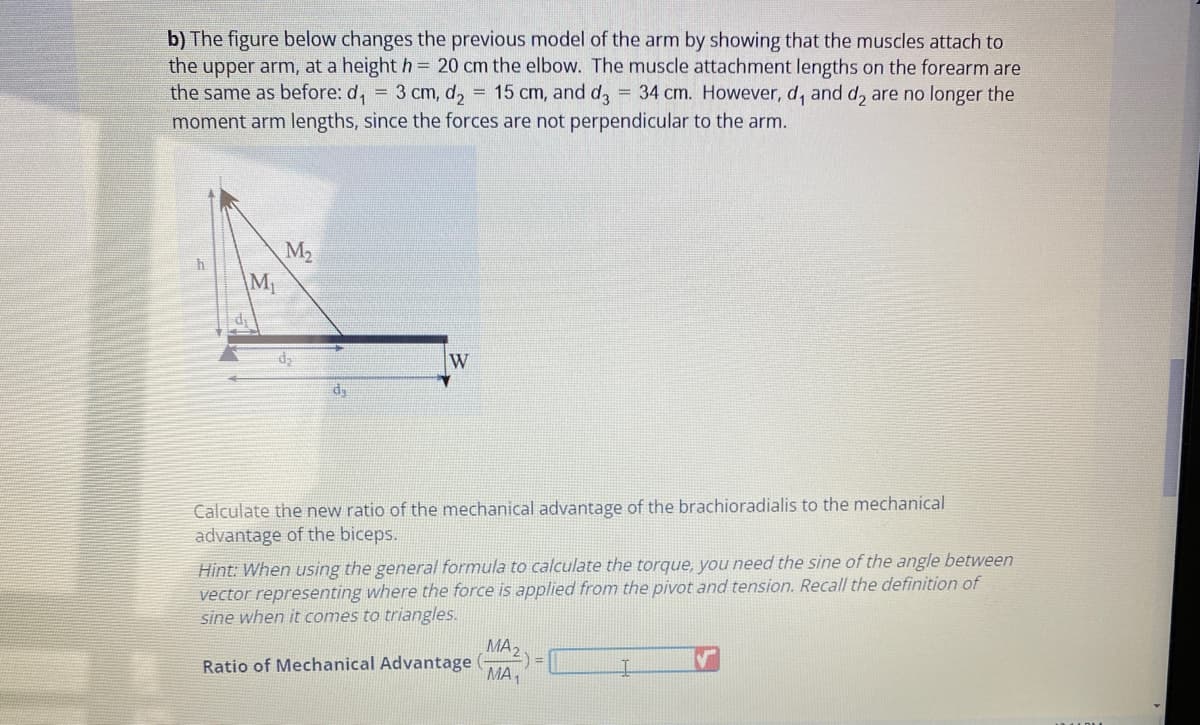b) The figure below changes the previous model of the arm by showing that the muscles attach to the upper arm, at a height h = 20 cm the elbow. The muscle attachment lengths on the forearm are the same as before: d₁ = 3 cm, d₂ = 15 cm, and d3 34 cm. However, d, and d₂ are no longer the moment arm lengths, since the forces are not perpendicular to the arm. = M₁ M₂ d₂ di W
b) The figure below changes the previous model of the arm by showing that the muscles attach to the upper arm, at a height h = 20 cm the elbow. The muscle attachment lengths on the forearm are the same as before: d₁ = 3 cm, d₂ = 15 cm, and d3 34 cm. However, d, and d₂ are no longer the moment arm lengths, since the forces are not perpendicular to the arm. = M₁ M₂ d₂ di W
Physics for Scientists and Engineers: Foundations and Connections
1st Edition
ISBN:9781133939146
Author:Katz, Debora M.
Publisher:Katz, Debora M.
Chapter5: Newton's Laws Of Motion
Section: Chapter Questions
Problem 76PQ: Jamal and Dayo are lifting a large chest, weighing 207 lb, by using the two rope handles attached to...
Related questions
Question

Transcribed Image Text:b) The figure below changes the previous model of the arm by showing that the muscles attach to
the upper arm, at a height h = 20 cm the elbow. The muscle attachment lengths on the forearm are
the same as before: d₁ = 3 cm, d₂ = 15 cm, and da = 34 cm. However, d, and d₂ are no longer the
moment arm lengths, since the forces are not perpendicular to the arm.
M₁
M₂
d₂
d₂
W
Calculate the new ratio of the mechanical advantage of the brachioradialis to the mechanical
advantage of the biceps.
Hint: When using the general formula to calculate the torque, you need the sine of the angle between
vector representing where the force is applied from the pivot and tension. Recall the definition of
sine when it comes to triangles.
Ratio of Mechanical Advantage (
MA2
MA₁
) =
I
Expert Solution
This question has been solved!
Explore an expertly crafted, step-by-step solution for a thorough understanding of key concepts.
This is a popular solution!
Trending now
This is a popular solution!
Step by step
Solved in 5 steps with 2 images

Knowledge Booster
Learn more about
Need a deep-dive on the concept behind this application? Look no further. Learn more about this topic, physics and related others by exploring similar questions and additional content below.Recommended textbooks for you

Physics for Scientists and Engineers: Foundations…
Physics
ISBN:
9781133939146
Author:
Katz, Debora M.
Publisher:
Cengage Learning

Physics for Scientists and Engineers, Technology …
Physics
ISBN:
9781305116399
Author:
Raymond A. Serway, John W. Jewett
Publisher:
Cengage Learning

Glencoe Physics: Principles and Problems, Student…
Physics
ISBN:
9780078807213
Author:
Paul W. Zitzewitz
Publisher:
Glencoe/McGraw-Hill

Physics for Scientists and Engineers: Foundations…
Physics
ISBN:
9781133939146
Author:
Katz, Debora M.
Publisher:
Cengage Learning

Physics for Scientists and Engineers, Technology …
Physics
ISBN:
9781305116399
Author:
Raymond A. Serway, John W. Jewett
Publisher:
Cengage Learning

Glencoe Physics: Principles and Problems, Student…
Physics
ISBN:
9780078807213
Author:
Paul W. Zitzewitz
Publisher:
Glencoe/McGraw-Hill